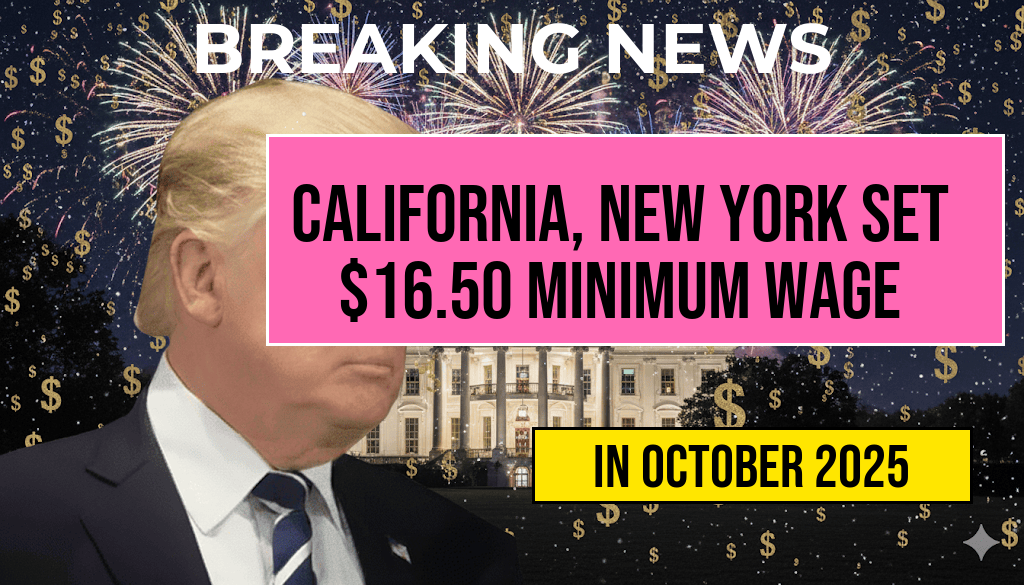California and New York are set to implement a significant increase in their minimum wage rates, raising the hourly pay to $16.50. This decision comes as both states continue to grapple with the rising cost of living and the need for a more equitable economy. The new wage law aims to provide relief for millions of low-wage workers who have been disproportionately affected by inflation and economic challenges exacerbated by the COVID-19 pandemic. As these states move forward, the changes are expected to impact various sectors, from retail to hospitality, and could set a precedent for other states considering similar measures.
Details of the Minimum Wage Increase
The minimum wage increase is scheduled to take effect on January 1, 2024, in both California and New York. This adjustment will mark a significant step in the ongoing efforts to ensure that workers earn a livable wage. Currently, California’s minimum wage stands at $15.50 per hour, while New York’s is $15.00 per hour in most areas, though some cities, like New York City, have already exceeded this amount.
Key Points of the Legislation
- Effective Date: January 1, 2024
- New Minimum Wage: $16.50 per hour
- Current Rates: California – $15.50; New York – $15.00 (most areas)
- Target Groups: Low-wage workers in various industries
Economic Context and Implications
As the cost of living continues to rise, both states have faced increased pressure from advocacy groups and labor unions to enhance compensation for workers. A recent study indicated that many families in California and New York struggle to meet basic needs despite working full-time jobs. The increase to $16.50 per hour is seen as a necessary step toward addressing income inequality and improving the standard of living for low-wage employees.
| State | Current Minimum Wage | Future Minimum Wage (2024) |
|---|---|---|
| California | $15.50 | $16.50 |
| New York | $15.00 | $16.50 |
Responses from Stakeholders
The response to the wage increase has been mixed among various stakeholders. Labor advocates have hailed the decision as a victory for workers, arguing that it will help alleviate poverty and stimulate local economies. “This is a critical step towards ensuring that all workers can provide for their families,” said Maria Lopez, a spokesperson for the California Labor Federation.
Conversely, some business groups have expressed concerns about the potential impacts on small businesses. They argue that increasing labor costs could force some employers to reduce staff or cut hours to maintain profitability. “While we support fair wages, we are worried about the unintended consequences this could have on job creation,” commented John Smith, a representative for the New York Business Council.
Future Considerations
As California and New York prepare to implement the new minimum wage, other states are closely monitoring these developments. Many are considering similar increases in response to the growing movement advocating for higher wages nationwide. States like Massachusetts and Washington have already enacted their own minimum wage increases, and the conversation around wage reform is gaining momentum across the country.
The potential ripple effects of these changes could also influence federal minimum wage discussions. Currently, the federal minimum wage remains stagnant at $7.25 per hour, a figure that has not changed since 2009. The disparity between state and federal rates has prompted renewed calls for a nationwide increase, highlighting the urgent need for comprehensive wage reform.
Conclusion: A Step Forward for Workers
The implementation of a $16.50 minimum wage in California and New York represents a pivotal moment in the ongoing battle for fair wages. As these states take the lead, many will be watching closely to see how these changes affect workers, businesses, and the economy as a whole. With the cost of living continuing to rise, the importance of equitable wages has never been more apparent.
For more information on minimum wage laws, you can visit the Wikipedia Minimum Wage page or check out the analysis from Forbes.
Frequently Asked Questions
What is the new minimum wage in California and New York?
The new minimum wage in California and New York is set at $16.50 per hour.
When will the new minimum wage take effect?
The implementation date for the $16.50 hourly minimum wage is scheduled for 2024, but specific dates may vary by state.
Who will be affected by the minimum wage increase?
The minimum wage increase will affect all workers in California and New York earning below the new hourly rate, including part-time and full-time employees.
Are there any exceptions to the new minimum wage law?
Yes, some exceptions may apply to certain industries or workers, such as those receiving tips or certain training programs. It is important to check local laws for specific details.
How will this minimum wage increase impact businesses?
The increase to $16.50 per hour may lead to higher labor costs for businesses in California and New York, prompting some to adjust their pricing, reduce hours, or implement other cost-saving measures.










